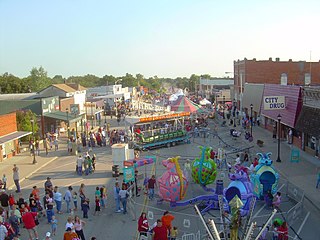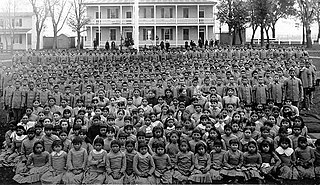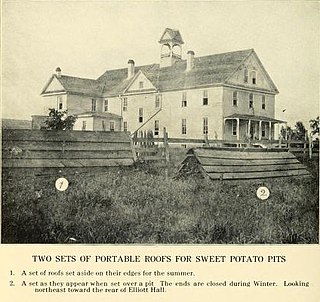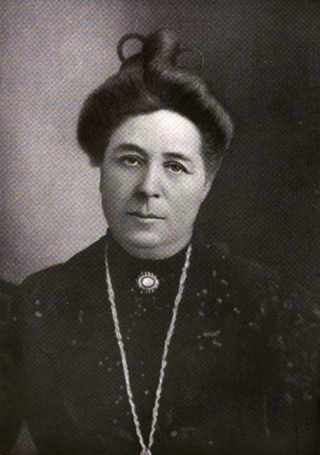
Okmulgee County is a county in the U.S. state of Oklahoma. As of the 2020 census, the population was 36,706. The county seat is Okmulgee. Located within the Muscogee Nation Reservation, the county was created at statehood in 1907. The name Okmulgee is derived from the Hitchita word okimulgi, meaning "boiling waters".

Okmulgee is a city in, and the county seat of, Okmulgee County, Oklahoma. The name is from the Mvskoke word okimulgee, which means "boiling waters". The site was chosen because of the nearby rivers and springs. Okmulgee is 38 miles south of Tulsa and 13 miles north of Henryetta via US-75. Okmulgee is part of the Tulsa Metropolitan Area.

Coweta is a city in Wagoner County, Oklahoma, United States, a suburb of Tulsa. As of 2010, its population was 9,943. Part of the Creek Nation in Indian Territory before Oklahoma became a U.S. state, the town was first settled in 1840.

Dwight Presbyterian Mission was one of the first American missions to the Native Americans. It was established near present-day Russellville, Arkansas in 1820 to serve the Arkansas Cherokees. After the Cherokee were required to move to Indian Territory in 1828, the mission was reestablished in 1829 near present-day Marble City, Oklahoma. The mission is listed on the National Register of Historic Places.

Alice Mary Robertson was an American educator, social worker, Native Americans' rights activist, government official, and politician who became the second woman to serve in the United States Congress, and the first from the state of Oklahoma. Robertson was the first woman to defeat an incumbent congressman. She was known for her strong personality, commitment to Native American issues, and anti-feminist stance.

Samuel Austin Worcester, was an American missionary to the Cherokee, translator of the Bible, printer, and defender of the Cherokee sovereignty. He collaborated with Elias Boudinot (Cherokee) in Georgia to establish the Cherokee Phoenix, the first Native American newspaper, which was printed in both English and the Cherokee syllabary. The Cherokee gave Worcester the honorary name A-tse-nu-sti, which translates to "messenger" in English.
Chahta Tamaha served as the capital of the Choctaw Nation from 1863 to 1883 in Indian Territory. The town developed initially around the Armstrong Academy, which was operated by Protestant religious missionaries from 1844 to 1861 to serve Choctaw boys. After the capital was relocated to another town, this community declined.

Koweta Mission Site is a site near Coweta, Oklahoma, and listed on the National Register of Historic Places. The mission was started in 1843 by Presbyterian minister Robert Loughridge at Coweta, then the capital of the Creek Nation, Indian Territory. He named the mission "Koweta", after the Creek capital. The school operated until the American Civil War, when Loughridge and most missionaries left the territory.
Tullahassee Mission was a Presbyterian mission and school, founded on March 1, 1850, in the Creek Nation, Indian Territory by Robert Loughridge. This Presbyterian minister had been serving there since 1843, when he founded Koweta Mission. This mission was also originally built for Muscogee Creek students, and the community of Tullahassee developed there.

Robert McGill Loughridge was an American Presbyterian missionary who served among the Creek in Indian Territory. He attended Miami University, Ohio, and graduated in 1837. Loughridge was ordained as a Presbyterian minister in October 1842.

The Thomas-Foreman Historic Home, also known as the Grant Foreman House, is a house in Muskogee, Oklahoma, United States, built by Judge John R. Thomas on a tract of prairie land. It was later named after Thomas' son-in-law, Grant Foreman, by the Muskogee Historical Society and the National Register of Historic Places.

American Indian boarding schools, also known more recently as American Indian residential schools, were established in the United States from the mid-17th to the early 20th centuries with a primary objective of "civilizing" or assimilating Native American children and youth into European American culture. In the process, these schools denigrated Native American culture and made children give up their languages and religion. At the same time the schools provided a basic Western education. These boarding schools were first established by Christian missionaries of various denominations. The missionaries were often approved by the federal government to start both missions and schools on reservations, especially in the lightly populated areas of the West. In the late 19th and early 20th centuries especially, the government paid religious orders to provide basic education to Native American children on reservations, and later established its own schools on reservations. The Bureau of Indian Affairs (BIA) also founded additional off-reservation boarding schools based on the assimilation model. These sometimes drew children from a variety of tribes. In addition, religious orders established off-reservation schools.
Isparhecher, sometimes spelled "Isparhecker," and also known as Is-pa-he-che and Spa-he-cha, was known as a political leader of the opposition in the Creek Nation in the post-Civil War era. He led a group that supported traditional ways and was opposed to the assimilation encouraged by Chief Samuel Checote and others.
Nuyaka is a populated place in Okmulgee County, Oklahoma, United States. It is approximately 7.4 kilometres (4.6 mi) south-southwest of Beggs and is west of the city of Okmulgee off SH-56. The Old Nuyaka Cemetery and the Nuyaka Mission site are southwest of town. The elevation is 735 feet (224 m) and the coordinates are latitude 35.653 and longitude -96.14. It was notable as the center of traditionalist opposition to the Creek national government during the late 19th century.
Samuel Checote (1819–1884) (Muscogee) was a political leader, military veteran, and a Methodist preacher in the Creek Nation, Indian Territory. He served two terms as the first principal chief of the tribe to be elected under their new constitution created after the American Civil War. He had to deal with continuing tensions among his people, as traditionalists opposed assimilation to European-American ways.

Oak Hill Industrial Academy was founded as a day school and later became a boarding school for Choctaw Freedmen. It existed from 1878 to 1936. It was located in the far southeastern corner of the Choctaw Nation in Indian Territory in what is now Oklahoma. The original location was in the southwest corner of Section 27 near the present-day Valliant, Oklahoma. But in 1902 it was rebuilt in the northeast quarter of section 29 near the western line of McCurtain County, Indian Territory. The school closed in 1936, and no evidence of it other than a historical marker remains.

Sophia Alice Callahan was a novelist and teacher of Muscogee heritage. Her novel, Wynema, a Child of the Forest (1891) is thought "to be the first novel written by a Native American woman." Shocked about the Massacre at Wounded Knee at the Pine Ridge Indian Reservation, which took place about six months before she published her book, Callahan added an account of this and the 1890 Ghost Dance of the Lakota to her book in the first fictional treatment of these subjects. This may have been "the first novel written in Oklahoma," which was at the time Indian Territory. Callahan wrote in a romantic novel style but she also clearly intended what has been called a "reform novel," identifying many wrongs suffered by Native Americans in United States society. After being discovered in the late 20th century, the novel was reprinted in 1997. It has been the subject of scholarly studies.

Lilah Denton Lindsey was a Native American philanthropist, civic leader, women's community organizer, temperance worker, and teacher. She was the first Muscogee woman to earn a college degree. She led numerous civic organizations and served as president of the Indian Territory Woman's Christian Temperance Union (WCTU).
The Oklahoma-Southwestern Railway (“OSR”) ran between Bristow, Oklahoma and Nuyaka, Oklahoma. It operated from 1920 to 1930 before being abandoned.















